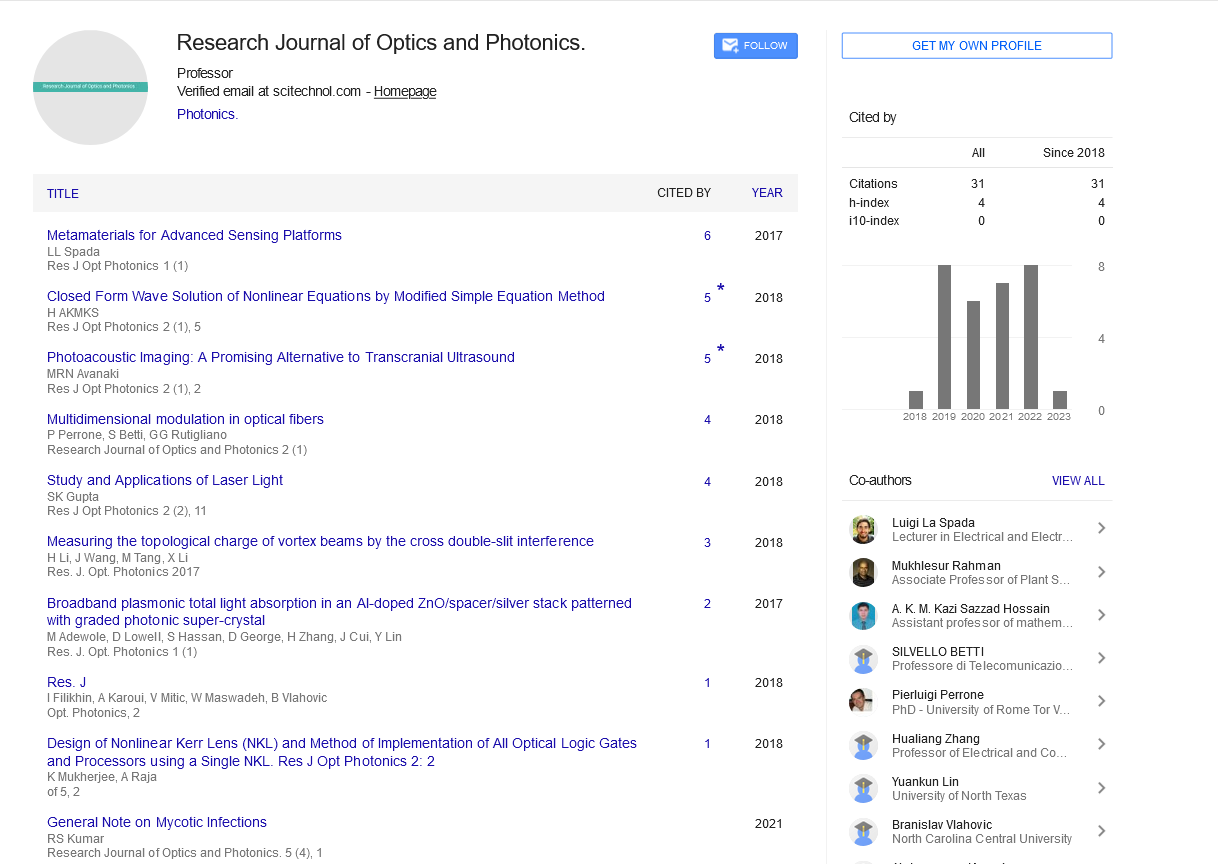Opinion Article, J Opt Photonics Vol: 7 Issue: 4
Applications and Challenges of Practical Spectroscopy beyond the Laboratory
Kwang Hyon*
1Institute of Physics, State Academy of Sciences, Pyongyang, South Korea
*Corresponding Author: Kwang Hyon,
Institute of Physics, State Academy of
Sciences, Pyongyang, South Korea
E-mail: kim@hyon.kr
Received date: 22 November, 2023, Manuscript No. RJOP-24-128325;
Editor assigned date: 24 November, 2023, PreQC No. RJOP-24-128325 (PQ);
Reviewed date: 08 December, 2023, QC No. RJOP-24-128325;
Revised date: 15 December, 2023, Manuscript No RJOP-24-128325 (R);
Published date: 22 December, 2023, DOI: 10.4172/RJOP.23.7.1000053.
Citation: Hyon K (2023) Applications and Challenges of Practical Spectroscopy beyond the Laboratory. Res J Opt Photonics 7:4.
Description
Spectroscopy, a powerful analytical technique that explores the interaction between electromagnetic radiation and matter, has long been a staple in laboratory settings. However, its utility extends far beyond the confines of research facilities, finding diverse applications in real-world scenarios across various industries and fields. From environmental monitoring to medical diagnostics, spectroscopy plays a crucial role in addressing contemporary challenges and advancing scientific knowledge. This essay explores the real-world applications of spectroscopy and the challenges associated with its implementation outside the laboratory. One of the most prominent applications of spectroscopy beyond the laboratory is in environmental monitoring and analysis. Spectroscopic techniques, such as Infrared (IR) and Ultraviolet-Visible (UV-Vis) spectroscopy, are used to analyze air, water, and soil samples for pollutants, contaminants, and other environmental indicators. For instance, Fourier-Transform Infrared (FTIR) spectroscopy enables the identification and quantification of organic and inorganic compounds in water and soil samples, facilitating environmental remediation efforts and ensuring compliance with regulatory standards.
Similarly, Raman spectroscopy offers a non-destructive and labelfree method for analyzing chemical composition and molecular structure in environmental samples. By probing the vibrational modes of molecules, Raman spectroscopy can identify pollutants, such as heavy metals and hydrocarbons, in water and soil matrices, providing valuable insights into environmental contamination and ecosystem health. These spectroscopic techniques play a vital role in monitoring environmental quality, assessing pollution levels, and informing environmental management decisions. In the field of healthcare, spectroscopy finds widespread applications in medical diagnostics and disease monitoring. Techniques such as Nuclear Magnetic Resonance (NMR) spectroscopy and Mass Spectrometry (MS) are used for metabolomic profiling and biomarker discovery in biological samples, such as blood, urine, and tissue specimens. NMR spectroscopy, for example, enables the identification and quantification of metabolites in biofluids, providing insights into disease mechanisms and metabolic pathways.
Furthermore, optical spectroscopic methods, including fluorescence spectroscopy and Near-Infrared (NIR) spectroscopy, are employed for non-invasive diagnosis and monitoring of various diseases, such as cancer, diabetes, and cardiovascular disorders. Fluorescence spectroscopy, for instance, can detect fluorescent markers and autofluorescent biomolecules associated with disease progression, facilitating early detection and treatment monitoring. NIR spectroscopy offers a rapid and cost-effective method for analyzing biological tissues and fluids, providing diagnostic information without the need for invasive procedures or sample preparation. In the agricultural sector, spectroscopy plays a crucial role in crop monitoring, quality assessment, and food safety. Hyperspectral imaging, a technique that combines spectroscopy with imaging, enables the spatial mapping of biochemical properties and physiological parameters in plants and agricultural products.
Moreover, spectroscopic techniques, such as Infrared Spectroscopy and Chromatography Coupled with Mass Spectrometry (GC-MS and LC-MS), are used for the authentication and adulteration detection of food products. By analyzing the chemical composition and molecular structure of food samples, spectroscopy can identify counterfeit ingredients, additives, and contaminants, safeguarding consumer health and promoting food authenticity and traceability. While spectroscopy offers numerous benefits and opportunities in real-world applications, its implementation outside the laboratory poses several challenges. One of the primary challenges is instrument portability and miniaturization, particularly for field-deployable and point-of-care devices. Developing compact and robust spectroscopic instruments capable of delivering accurate and reliable measurements in harsh and remote environments remains a significant engineering and design challenge.
Additionally, spectroscopic data analysis and interpretation require specialized expertise and computational resources, which may be limited in field settings. Developing user-friendly software tools and algorithms for real-time data processing and analysis is essential for enabling on-site decision-making and rapid response in applications such as environmental monitoring and medical diagnostics. Furthermore, standardization and validation of spectroscopic methods and techniques are critical for ensuring data quality, comparability, and reproducibility across different measurement platforms and settings.
Conclusion
In conclusion, spectroscopy's real-world applications extend far beyond the laboratory, encompassing diverse fields such as environmental monitoring, healthcare, agriculture, and food safety. By providing valuable insights into the chemical composition, molecular structure, and physical properties of materials and substances, spectroscopy plays a crucial role in addressing contemporary challenges and advancing scientific knowledge. However, implementing spectroscopic techniques outside the laboratory presents several challenges, including instrument portability, data analysis, and standardization. Overcoming these challenges requires interdisciplinary collaboration, technological innovation, and a concerted effort to harness the full potential of spectroscopy in addressing real-world problems and improving quality of life.
 Spanish
Spanish  Chinese
Chinese  Russian
Russian  German
German  French
French  Japanese
Japanese  Portuguese
Portuguese  Hindi
Hindi 